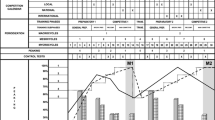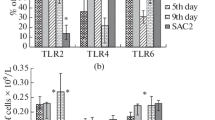Abstract
Elite level athletes seem to be prone to illness especially during heavy training phases. The aim of this study was to investigate the influence of long term intensive training on the functional features of innate immune cells from high competitive level swimmers, particularly the production of inflammatory mediators and the possible relationship with upper respiratory symptoms (URS) occurrence. A group of 18 swimmers and 11 healthy non athletes was studied. Peripheral blood samples were collected from athletes after 36 h of resting recovery from exercise at four times during the training season and at three times from non athletes. Samples were incubated in the presence or absence of LPS and IFN-γ and the frequency of cytokine-producing cells and the amount produced per cell were evaluated by flow cytometry. In addition, plasma cortisol levels were measured and URS recorded through daily logs. The athletes, but not the controls, showed a decrease in the number of monocytes, neutrophils, and dendritic cell (DC) subsets and in the amount of IL-1β, IL-6, IL-12, TNF-α, and MIP-1β produced after stimulation, over the training season. Differences were most noticeable between the first and second blood collections (initial increase in training volume). Athlete’s cortisol plasma levels partially correlated with training intensity and could help explain the reduced in vitro cell response to stimulation. Our results support the idea that long-term intensive training may affect the function of innate immune cells, reducing their capacity to respond to acute challenges, possibly contributing to an elevated risk of infection.




Similar content being viewed by others
References
Akahoshi T, Sasahara T, Namai R, Matsui T, Watabe H, Kitasato H, Inoue M, Kondo H (2003) Production of macrophage inflammatory protein 3{alpha} (MIP-3{alpha}) (CCL20) and MIP-3{beta} (CCL19) by human peripheral blood neutrophils in response to microbial pathogens. Infect Immun 71(1):524–526
Almeida J, Bueno C, Algueró M, Sanchez M, de Santiago M, Escribano L, Díaz-Agustín B, Vaquero J, Laso F, San Miguel J (2001) Comparative analysis of the morphological, cytochemical, immunophenotypical, and functional characteristics of normal human peripheral blood lineage-/CD16+/HLA-DR+/CD14-/lo cells, CD14+ monocytes, and CD16-dendritic cells. Clin Immunol 100(3):325–338
Banchereau J, Steinman RM (1998) Dendritic cells and the control of immunity. Nature 392(6673):245–252
Bermon S (2007) Airway inflammation and upper respiratory tract infection in athletes: is there a link. Exerc Immunol Rev 13:6–14
Bishop N (2006) Exercise and infection risk. In: Gleeson M (ed) Immune function in sport and exercise. Churchill Livingstone Elsevier, Edinburgh, pp 1–14
Cox AJ, Gleeson M, Pyne DB, Callister R, Hopkins WG, Fricker PA (2008) Clinical and laboratory evaluation of upper respiratory symptoms in elite athletes. Clin J Sport Med 18(5):438–445
Crespo I, Paiva A, Couceiro A, Pimentel P, Orfão A, Regateiro F (2004) Immunophenotypic and functional characterization of cord blood dendritic cells. Stem Cells Dev 13(1):63–70
Curfs J, Meis J, Hoogkamp-Korstanje J (1997) A primer on cytokines: sources, receptors, effects, and inducers. Clin Microb Rev 10(4):742–780
Dinarello C (1992) Interleukin-1 and tumor necrosis factor: effector cytokines in autoimmune diseases. Semin Immunol 4(3):133–145
Dinarello C (1997) Role of pro-and anti-inflammatory cytokines during inflammation: experimental and clinical findings. J Biol Regul Homeost Agents 11(3):91–103
Dorner B, Scheffold A, Rolph M, Hüser M, Kaufmann S, Radbruch A, Flesch I, Kroczek R (2002) MIP-1α, MIP-1β, RANTES, and ATAC/lymphotactin function together with IFN-γ as type 1 cytokines. PNAS 99(9):6181–6186
Fischer J, Hasselgren P (1991) Cytokines and glucocorticoids in the regulation of the “hepato-skeletal muscle axis” in sepsis. Am J Surg 161(2):266–271
Fricker PA, Pyne DB, Saunders PU, Cox AJ, Gleeson M, Telford RD (2005) Influence of training loads on patterns of illness in elite distance runners. Clin J Sport Med 15(4):246–252
Gallin J (1984) Human neutrophil heterogeneity exists, but is it meaningful? Blood 63(5):977–983
Gleeson M (2006a) Immune system adaptation in elite athletes. Curr Opin Clin Nutr Metab Care 9(6):659–665
Gleeson M (2006b) Immune function in sport and exercise, 1st edn. Churchill Livingstone Elsevier, London
Gleeson M (2007) Immune function in sport and exercise. J Appl Physiol 103(2):693–699
Gleeson M, McDonald W, Cripps A, Pyne D, Clancy R, Fricker P (1995) The effect on immunity of long-term intensive training in elite swimmers. Clin Exp Immunol 102(1):210–216
Gleeson M, Pyne D, Callister R (2004) The missing links in exercise effects on mucosal immunity. Exerc Immunol Rev 10:107–128
Glesson M, MacDonald WA, Pyne D, Cripss AW, Francis JK, Fricker PA, Clancy LR (1999) Salivary IgA levels and infection risk in elite swimmers. Med Sci Sports Exerc 31:67–73
Heath GW, Macera CA, Nieman DC (1992) Exercise and upper respiratory tract infection: is there a relationship? Sports Med 14(6):353–365
Ho CK, Lopez JA, Vuckovic S, Pyke CM, Hockey RL, Hart DN (2001) Surgical and physical stress increases circulating blood dendritic cell counts independently of monocyte counts. Blood 98(1):140–145
Luster AD (2002) The role of chemokines in linking innate and adaptive immunity. Curr Opin Immunol 14(1):129–135
MacIntyre D, Reid W, McKenzie D (1995) Delayed muscle soreness. The inflammatory response to muscle injury and its clinical implications. Sports Med 20(1):24–40
Malm C (2004) Exercise immunology: the current state of man and mouse. Sports Med 34(9):555–566
Manetti R, Parronchi P, Giudizi M, Piccinni M, Maggi E, Trinchieri G, Romagnani S (1993) Natural killer cell stimulatory factor (interleukin 12 [IL-12]) induces T helper type 1 (Th1)-specific immune responses and inhibits the development of IL-4-producing Th cells. J Exp Med 177(4):1199–1204
Matthews CE, Ockene I, Freedson PS, Rosal MC, Merriam PA, Hebert JR (2002) Moderate to vigorous physical activity and risk of upper-respiratory tract infection. Med Sci Sports Exerc 34(8):1242–1248
Morgado JM, Pratas R, Laranjeira P, Henriques A, Crespo I, Regateiro F, Paiva A (2008) The phenotypical and functional characteristics of cord blood monocytes and CD14(-/low)/CD16(+) dendritic cells can be relevant to the development of cellular immune responses after transplantation. Transpl Immunol 19(1):55–63
Mujika I, Chatard JC, Busso T, Geyssant A, Barale F, Lacoste L (1995) Effects of training on performance in competitive swimming. Can J Appl Physiol 20(4):395–406
Nieman D (1998) Exercise and resistance to infection. Can J Physiol Pharmacol 76(5):573–580
Nieman D (2000) Is infection risk linked to exercise workload? Med Sci Sports Exerc 32(7):S406–S411
Nieman D (2003) Current perspective on exercise immunology. Curr Sports Med Rep 2(5):239–242
Nieman D, Nehlsen-Cannarella S, Fagoaga O, Henson D, Shannon M, Davis J, Austin M, Hisey C, Holbeck J, Hjertman J (1999) Immune response to two hours of rowing in elite female rowers. Int J Sports Med 20:476–481
Pyne D, McDonald W, Gleeson M, Flanagan A, Clancy R, Fricker P (2001) Mucosal immunity, respiratory illness, and competitive performance in elite swimmers. Med Sci Sports Exerc 33(3):348–353
Reeser J, Willick S, Elstad M (2003) Medical services provided at the Olympic Village polyclinic during the 2002 Salt Lake City Winter Games. Wis Med J 102(4):20–25
Shephard RJ, Shek PN (1999) Effects of exercise and training on natural killer cell counts and cytolytic activity: a meta-analysis. Sports Med 28(3):177–195
Smith L (1991) Acute inflammation: the underlying mechanism in delayed onset muscle soreness? Med Sci Sports Exerc 23(5):542–551
Smith J (1994) Neutrophils, host defense, and inflammation: a double-edged sword. J Leukoc Biol 56(6):672–686
Smith L (2003) Overtraining, excessive exercise, and altered immunity: is this a T helper-1 versus T helper-2 lymphocyte response? Sports Med 33(5):347–364
Spence L, Brown WJ, Pyne DB, Nissen MD, Sloots TP, McCormack JG, Locke AS, Fricker PA (2007) Incidence, etiology, and symptomatology of upper respiratory illness in elite athletes. Med Sci Sports Exerc 39(4):577–586
Ziegler-Heitbrock H, Fingerle G, Ströbel M, Schraut W, Stelter F, Schütt C, Passlick B, Pforte A (1993) The novel subset of CD14+/CD16+ blood monocytes exhibits features of tissue macrophages. Eur J Immunol 23(9):2053–2058
Acknowledgments
This work was supported by grant PTDC/DES/68647/2006 from the Portuguese Foundation for Science and Technology “Fundação para a Ciência e Tecnologia” (FCT)
Author information
Authors and Affiliations
Corresponding author
Additional information
Communicated by William J. Kraemer.
José Mário Morgado and Luís Rama contributed equally to this work.
Rights and permissions
About this article
Cite this article
Morgado, J.M., Rama, L., Silva, I. et al. Cytokine production by monocytes, neutrophils, and dendritic cells is hampered by long-term intensive training in elite swimmers. Eur J Appl Physiol 112, 471–482 (2012). https://doi.org/10.1007/s00421-011-1966-4
Received:
Accepted:
Published:
Issue Date:
DOI: https://doi.org/10.1007/s00421-011-1966-4




